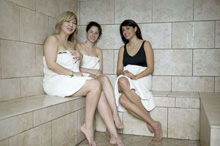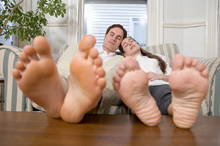Athlete’s Foot: How to Get Rid of This Common and
Incredibly Itchy Fungal Infection
by www.SixWise.com
Athlete’s foot is one of the most common skin infections around, and usually attacks your feet in the dark, damp areas between your toes. Fungus, of course, love moist environments of all kinds, including showers, swimming pools and locker rooms, the latter of which is why this infection got the name “athlete’s foot.”
|

Locker rooms aren’t the only place you can pick up athlete’s foot -- it’s also common in saunas, swimming pools and communal showers and baths.
|
Top Symptoms of Athlete’s Foot
If you have one or several of the symptoms below, you could have athlete’s foot:
-
Itching, stinging or burning between your toes or on the soles of your feet
-
Itchy blisters
-
Cracking and peeling skin between your toes and on the soles of your feet
-
Excessively dry skin on the bottoms or sides of your feet
-
Thick, crumbly toenails that are discolored or pulling away from the nail bed
Not all skin irritations on your feet are athlete’s foot, however. Eczema, psoriasis or even a reaction to dyes or adhesives in your shoes can cause similar symptoms.
It’s also possible to transmit athlete’s foot to other parts of your body, such as your groin or underarms.
Causes of Athlete’s Foot
Athlete’s foot is contagious and spreads easily from person to person. You can catch it by skin-to-skin contact with an infected person (it’s possible to carry the fungus that causes athlete’s foot and not have any symptoms) or by touching an object that carries the fungus.
Common objects that may transmit athlete’s foot are floors, mats, rugs, bed linens, shoes and clothes, or spending time in locker rooms, saunas, swimming pools, or communal baths and showers (especially if you walk barefoot in these areas). Once the fungus is on your feet, it can then grow in your shoes, especially if your shoes are tight-fitting or let in little air (such as plastic shoes).
You may also be at a higher risk of getting athlete’s foot if you are a man, have a weakened immune system or wear damp socks (which encourage the fungus to grow). Further, once you’ve had athlete’s foot, you’re more likely to get it again.
Treating Athlete’s Foot Naturally
Athlete’s foot can be incredibly uncomfortable and even painful in serious cases, so you will want a treatment that works fast as well as effectively, and for this Sixwise.com highly recommends Kolorex® Foot & Toe Care Cream.
Kolorex is a natural formula made with Horopito, a powerful anti-fungal herb that grows only in New Zealand and has been used since ancient times to relieve skin diseases.
Kolorex contains the strongest Horopito™extract (kolorXtract-50™) for rapid relief of problems associated with foot and toe fungi. In addition, this formulation contains lemon tea tree oil for deep down cleansing, Apricot kernel oil to soothe, Aloe extract to replenish and natural source Vitamin E to condition problem skin.
Plus, Kolorex® Foot & Toe Care Cream is free from synthetic preservatives, mineral oils, synthetic fragrances, parabens and animal products -- it is completely natural!
Eight More Natural Tips for Treating and Preventing Athlete’s Foot
|

Beat Athlete’s Foot With Nature’s Most Powerful Anti-Fungal Herb!
Kolorex® Foot & Toe Care Cream is a natural formula made with Horopito, a powerful anti-fungal herb that has been used since ancient times to relieve skin diseases.
Kolorex Foot & Toe Care contains:
-
Lemon tea tree oil for deep down cleansing
-
Apricot kernel oil to soothe
-
Aloe extract to replenish
-
Natural source vitamin E to condition problem skin
Plus, Kolorex® Foot & Toe Care Cream is free from synthetic preservatives, mineral oils, synthetic fragrances, parabens and animal products -- it is completely natural!
|
Although the fungus that causes athlete’s foot is very easy to pick up, a bit of good foot hygiene can go a long way toward preventing this infection:
-
Wash your feet with soap and water daily
-
Dry your feet carefully, especially between your toes
-
Change your socks regularly to decrease moisture, especially if you perspire a lot
-
Wear socks made from natural materials like cotton or wool, or those made from a synthetic material that is designed to wick moisture from your feet
-
Try a daily foot powder to keep your feet dry
-
Wear light, airy, well-ventilated shoes, and alternate your shoes often so they have time to dry thoroughly
-
Avoid walking barefoot in communal showers, pools, fitness centers and locker rooms
-
Don’t borrow shoes as you could pick up a fungal infection
If you suspect you have athlete’s foot and it does not improve within two weeks of self-care, see a podiatrist to find out if a fungus is really the source of your problem.
Recommended Reading
You are Burying Your Face in a Hot Zone for Fungal Spores Every Night: Your Pillow
From Skin Boils to Pimples to Warts to Moles: What Exactly is That Stuff on Your Skin?
Sources
American Podiatric Medical Association
MayoClinic.com Athlete’s Foot
WebMD.com Athlete’s Foot